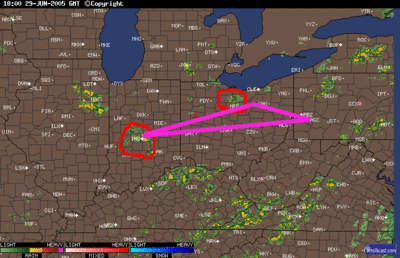Today was supposed to be an Angel Flight from AGC to EYE. But yesterday, we got hammered by strong TS. Turns out it was about a 20 mile wide band that moved from SW to NE. Some of my pals saw nothing; the soccer match I was officiating had to be delayed 45 minutes due to lightning, and then moved to an adjacent field that wasn't underwater.So I was very concerned about making a trip this afternoon. It's been plenty hot here of late, providing much fuel for the boomer clouds. I didn't want to abandon the passenger, but neither did I want to do damage to myself or my plane.The FAs for the areas of flight were't too enlightening:PA
ERN 2/3...BKN050 OVC100 TOP FL250. VIS 3-5SM BR. WDLY SCT SHRA.
15Z SCT-BKN060 BKN120. ISOL -SHRA. BY 19Z WDLY SCT TSRA. CB
TOP FL350. OTLK...VFR SHRA.
WRN 1/3...BKN-OVC040 TOP 080. VIS 3-5SM BR. 15Z BKN060 TOP 100.
OCNL -RA. 18Z ST-BKN060. WDLY SCT TSRA. CB TOP FL380.
OTLK...VFR.
OH LE
LE/ERN HLF OH...BKN020 TOP 040 BKN CI. VIS 3-5SM BR. ISOL EMBD -
TSRA. CB TOP FL300. 14Z SCT060 BKN CI. BY 18Z WDLY SCT TSRA.
CB TOP FL400. OTLK...VFR.
WRN HALF OH...SCT050 SCT-BKN120 TOP FL200. VIS 3-5SM BR. ISOL -
TSRA. CB TOP FL300. 17Z SCT-BKN060 BKN120. WDLY SCT TSRA. CB
TOP FL400. OTLK...VFR TSRA. 00Z VFR.
IN
NRN...BKN100. ISOL -SHRA. OCNL VIS 4-6SM BR HZ TIL 15Z. 18-21Z
AGL SCT050 BKN-SCT120. OTLK...VFR.
SRN...SKC. OCNL VIS 3-5SM BR HZ TIL 15Z. 17-19Z AGL SCT050. AFT
20Z ISOL -TSRA. OTLK...VFR.
A couple of the TAFs had me worried, though, especially about the trip back:TAF KCMH 291123Z 291212 VRB02KT 4SM BR BKN150
FM1300 VRB04KT P6SM SCT040CB TEMPO 1720 3SM -TSRA BKN035CB
FM2000 22004KT P6SM SCT050
FM2300 VRB02KT P6SM SCT250
FM0500 00000KT 4SM BR SCT250
TAF KLCK 291123Z 291212 VRB02KT 3SM BR BKN150
FM1300 VRB04KT P6SM SCT040CB
TEMPO 1720 3SM -TSRA BKN035CB
FM2000 18004KT P6SM SCT050
FM2300 VRB02KT P6SM SCT250
FM0200 00000KT 4SM BR SCT250
TEMPO 0912 1SM BR
TAF AMD KFFO 291409 21004KT 9000 BR FEW050 FEW120 BKN250 QNH3001INS
BECMG 1416 25015G25KT 4800 -TSRA SCT020 BKN030CB QNH3003INS
BECMG 2021 21004KT 9999 FEW030 SCT100 QNH2995INS WND VRB04KT AFT
01 T30/20Z T21/08Z AMD 1405
TAF KDAY 291123Z 291212 VRB04KT P6SM SCT040CB TEMPO 1618 3SM -TSRA
BKN035CB
FM2000 18005KT P6SM SCT050
FM2300 17003KT P6SM SCT250
FM0800 18004KT 5SM BR SCT250
All in all, to me, this added up to a pretty good chance that we'd be in the clouds, sans Stormscope. That's an easy no-go decision.Talked to the linking pilot, with whom I'd shared my concerns the night before. Turns out, he was able to put the passenger on a Southwest flight direct to IND for less than he'd have spent on avgas for his trusty steed. A bit of an inconvenience for the passenger, but at least she'll get home, and I get to remain in one piece.We'll see what actually develops on the radar later today. Meantime, it's back to my day job.














